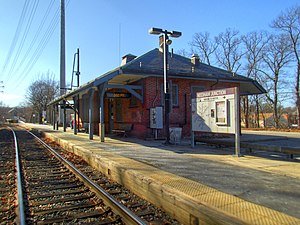
The Boston and Albany Railroad was a railroad connecting Boston, Massachusetts to Albany, New York, later becoming part of the New York Central Railroad system, Conrail, and CSX Transportation. The line is currently used by CSX for freight. Passenger service is provided on the line by Amtrak, as part of their Lake Shore Limited service, and by the MBTA Commuter Rail system, which owns the section east of Worcester and operates it as its Framingham/Worcester Line.

The Green Line D branch is a light rail line in Boston, Brookline, Cambridge, Newton, and Somerville, Massachusetts, operating as part of the Massachusetts Bay Transportation Authority (MBTA) Green Line. The line runs on a grade separated surface right-of-way for 9 miles (14 km) from Riverside station to Fenway station. The line merges into the C branch tunnel west of Kenmore, then follows the Boylston Street subway and Tremont Street subway to North Station. It is the longest and busiest of the four Green Line branches. As of February 2023, service operates on 8 to 9-minute headways at weekday peak hours and 8 to 11-minute headways at other times, using 13 to 19 trains.

The Highland branch, also known as the Newton Highlands branch, was a suburban railway line in Boston, Massachusetts. It was opened by the Boston and Albany Railroad in 1886 to serve the growing community of Newton, Massachusetts. The line was closed in 1958 and sold to the Metropolitan Transit Authority (MTA), the predecessor of the current Massachusetts Bay Transportation Authority (MBTA), which reopened it in 1959 as a light rail line, now known as the D branch of the Green Line.

The Boston and Providence Railroad was a railroad company in the states of Massachusetts and Rhode Island which connected its namesake cities. It opened in two sections in 1834 and 1835 - one of the first rail lines in the United States - with a more direct route into Providence built in 1847. Branches were built to Dedham in 1834, Stoughton in 1845, and North Attleboro in 1871. It was acquired by the Old Colony Railroad in 1888, which in turn was leased by the New Haven Railroad in 1893. The line became the New Haven's primary mainline to Boston; it was realigned in Boston in 1899 during the construction of South Station, and in Pawtucket and Central Falls in 1916 for grade crossing elimination.

The Needham Line is a branch of the MBTA Commuter Rail system, running west from downtown Boston, Massachusetts through Roxbury, Jamaica Plain, Roslindale, West Roxbury, and the town of Needham. The second-shortest line of the system at just 13.7 miles (22.0 km) long, it carried 4,881 daily riders in October 2022. Unlike the MBTA's eleven other commuter rail lines, the Needham Line is not a former intercity mainline; instead, it is composed of a former branch line, a short segment of one intercity line, and a 1906-built connector.

The Providence/Stoughton Line is an MBTA Commuter Rail service in Massachusetts and Rhode Island, primarily serving the southwestern suburbs of Boston. Most service runs entirely on the Northeast Corridor between South Station in Boston and Providence station or Wickford Junction station in Rhode Island, while the Stoughton Branch splits at Canton Junction and terminates at Stoughton. It is the longest MBTA Commuter Rail line, and the only one that operates outside Massachusetts. The line is the busiest on the MBTA Commuter Rail system, with 17,648 daily boardings in an October 2022 count.

Beaconsfield is an MBTA light rail station in Brookline, Massachusetts. It serves the Green Line D branch. It is located off Dean Road and Beaconsfield Road just south of Beacon Street. Like the other stops on the line, it was a commuter rail station on the Boston and Albany Railroad's Highland branch until 1958, when the line was closed and converted to a branch of what is now the Green Line. The station reopened along with the rest of the line in 1959.

Franklin/Dean College station is an MBTA Commuter Rail station located in Franklin, Massachusetts near Dean College. It serves the Franklin/Foxboro Line, for which it was the terminus from 1966 to 1988. The station has a mid-sized park and ride lot to serve town residents; Forge Park/495 station is intended to serve commuters from other nearby towns. The 1912-built station building still serves as a waiting hall and café, open during morning commute hours on weekdays. Franklin/Dean College station has a single side platform serving the line's single track; it is not accessible.

Hersey station is an MBTA Commuter Rail station in Needham, Massachusetts. Located in the Bird's Hill neighborhood, it serves the Needham Line. The station serves as a park-and-ride, with easy access from Route 128. Hersey station has been open since 1917, except for an 8-year closure during Southwest Corridor construction. It is fully accessible.
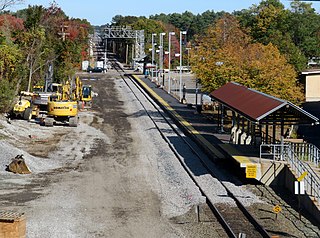
Norfolk station is an MBTA Commuter Rail station in Norfolk, Massachusetts, served by the Franklin/Foxboro Line. The station has one platform which serves a single track, with a mini-high section for accessibility. The Norfolk County Railroad opened through the North Wrentham village of Wrentham in 1849. A branch line to Medway was open from 1852 to 1864. The station was renamed Norfolk along with the town in 1870. Several different railroads operated the line, with the New York, New Haven and Hartford Railroad running it for much of the 20th century. Massachusetts Bay Transportation Authority (MBTA) subsidies began in 1966, and the agency bought the line in 1973. The mini-high platform was added in 1990.

Needham Center station is a commuter rail station on the MBTA Commuter Rail Needham Line, located just north of Great Plain Avenue (MA-135) in downtown Needham, Massachusetts. The first station at Needham opened in 1853; it burned in 1887 and was replaced with a stone station, some of which is still in place. The has a single side platform with an accessible mini-high platform serving the line's single track.

Needham Heights station is an MBTA Commuter Rail station in the Needham Heights neighborhood of Needham, Massachusetts. It is the terminus of the Needham Line. The station has one low-level side platform with a mini-high section for accessibility serving the single track of the Needham Branch.
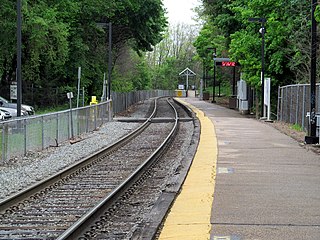
West Roxbury station is an MBTA Commuter Rail station in Boston, Massachusetts, served by the Needham Line. It is located on an embankment above Lagrange Street in the West Roxbury neighborhood. The station is accessible with a short mini-high platform on the outbound end of the main platform.
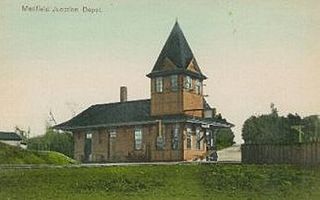
Medfield Junction is a railway junction and former train station located in northwest Medfield, Massachusetts. It is the junction of the Framingham Secondary and the former Millis Branch. The station was open from November 1861 until April 1967.
The Charles River Railroad was a railroad in the U.S. state of Massachusetts. It ran from a connection with the end of the Charles River Branch Railroad in Dover to Bellingham through the current-day towns of Medfield, Millis, and Medway.
The Woonsocket Union Railroad was a railroad in Rhode Island. It was incorporated in Rhode Island in 1850 to build a rail line from the Massachusetts state line near Woonsocket through the towns of Smithfield, Burrillville, and Glocester to the Connecticut state line.

The Dedham Branch was a spur line of the Boston and Providence Railroad, opened in 1835, which ran from the junction with the main line at Readville through to central Dedham; it was the first railroad branch line in Massachusetts. In 1966, it became part of the MBTA Commuter Rail system, but was abandoned the next year.

The Millis Branch was a branch of what is now the MBTA Commuter Rail system. Branching off the still-operating Needham Line at Needham Junction, it ran through the towns of Dover, Medfield, Millis, and Medway. Due to lack of subsidies and poor ridership, the line was cut back to Millis station in April 1966, and all service ended on April 21, 1967.
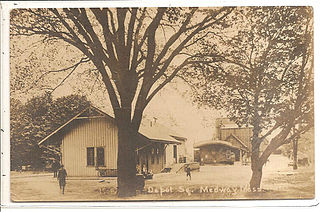
Medway station was a railroad station in Medway, Massachusetts. It served the West Medway Branch, and opened in 1861.

The history of rail in Dedham, Massachusetts begins with the introduction of the first rail line in 1836 and runs to the present day. Multiple railroads have serviced Dedham since then, and current service is provided by the MBTA. The station in Dedham Square built in 1881 out of Dedham Granite was demolished in 1951 and the stones were used to put an addition on the Town's library. There are two active stations today, and multiple others in close proximity.
